Why do the leaves of a rose wither and what to do?

A pink shrub with beautiful flowers is an adornment of any garden, landscape composition, city flower bed or front garden near the house. It's a shame to see when a plant planted to decorate the habitat suddenly starts to hurt and wither. To cure a diseased rose, it is necessary to find out the causes of the poor condition, and then eliminate their influence on the flower.

Bad conditions
Growers often find that caring for roses is pretty easy and nothing to worry about, but in fact, the plant can react unexpectedly sharply to changes in weather or growing conditions. If it became clear that with rather gentle care the leaves of the rose wither, then it is necessary to determine what exactly influenced such changes in the development of a previously healthy bush.
Unfavorable conditions can appear due to several reasons:
- dry season and lack of watering;
- excess moisture due to prolonged showers or rising groundwater levels;
- depletion of soil in the root zone and the emergence of nutrient deficiencies;
- infection with any kind of disease;
- pest attack.
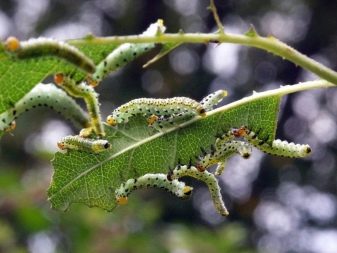

Mistakes made when planting rose bushes in the garden often become the only cause of plant disease and can lead to its death. Before choosing a place on the site for growing wonderful flowers, you need to make sure that the groundwater level is at least 1 meter to the surface.
Watering should be regular, but moderate, as flower bushes do not tolerate excess moisture. And also it is necessary to ensure that water does not stagnate in the root zone after rain. In cases where drainage was not made at the bottom of the hole during planting, you can arrange water drainage using a dug groove.
Roses prefer warm and open places, protected by walls of buildings, fences or dense plantings of trees from northerly winds and cold drafts. The growing conditions of bushes in shaded and mostly cool areas first lead to the appearance of spoiled foliage, and then to the complete disappearance of the plant.
The most successful choice of place would be a sunny area, which is well lit in the morning, and in the evening it remains in the shade.
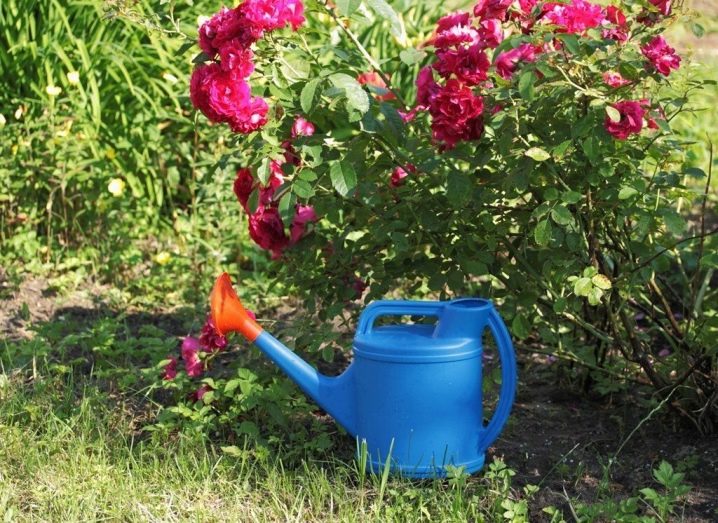
Various climatic features have a negative effect on the healthy life of a flower shrub. As a result of the abundant and prolonged rainy season, the soil becomes too wet, and most of the minerals needed to feed the roots are simply washed away by streams of water. At the same time, the owners of the garden are perplexed why the plant does not have enough fertilizers, which were applied in a timely manner.
Sudden weather changes, when the hot sun quickly appears in the sky after a cold rain, its scorching rays can heat water droplets on the leaves and leave burns. Burnt marks in the form of yellowing and drying of the affected areas can appear as a result of watering or spraying, which is done in the middle of the day, when sunlight falls on the plant.
Too hot weather or prolonged dry periods of summer are also bad for a healthy shrub.
You cannot change the climatic conditions, but you can also make sure that when planting a plant, it is as protected as possible from heat and other adverse effects that cause yellowing of the leaves and general wilting of the bush.

Improper care
When a grower sees the poor condition of his beloved rose bush, a natural question arises: what to do to save a beautiful plant that is withering. You should not immediately rush for additional root feeding if it has already been used in sufficient quantities. The fact is that many varieties of roses can sharply negatively react not only to a deficiency of nutrient minerals, but also to their excessive amount. Top dressing is necessary for a lush shrub, especially at the beginning of the flowering period, but this issue must be handled carefully so as not to create a problem with your own hands.
Lack of several basic types of fertilizers can cause quite visible and characteristic changes in the state of the rose leaves. For example, an insufficient amount of nitrogen fertilizers initially affects the saturation of the color of the leaves, which in roses are most often dark green. Then the foliage begins to acquire a yellowish color, like the tips of the petals, and as a result, everything dries and falls off. In the case of the resulting potassium deficiency, the leaves, on the contrary, darken, dry out and also fall to the ground. The lack of a sufficient amount of phosphorus in the feeding of rose bushes in the garden leads to a slowdown in all metabolic processes. As a result, the plant begins to age rapidly, the bark of its shoots stiffens, and it loses its vitality.

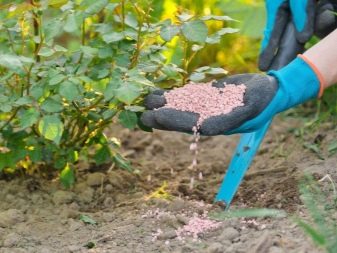
When not only young shoots or their tops wither in a rose, the reason for this phenomenon may be in disruption of the normal functioning of the root system. This can be not only the result of a strong drying out of the soil, but also a consequence of root decay from stagnant moisture or damage to them as a result of transplanting to a new place.
If the bush has recently been transferred to a new place, then it can be helped by creating conditions close to greenhouse ones. To do this, take a large plastic bag and put it on the bush. The package must be removed daily for 15 minutes for airing. At this time, the shoots are sprayed with warm boiled water so that the foliage is saturated with moisture, while the roots are recovering and cannot absorb enough water from the soil.
In this case, drugs help well: "Zircon" - for applying under the root and "Epin" - for adding to spray solutions.
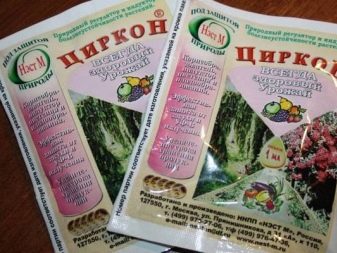
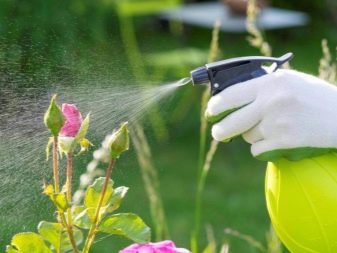
Treatment of diseases
The health of rose bushes is influenced by the development of many diseases, such as cytosporosis, gray rot, rust on foliage, powdery mildew and spotting. Diseased plants lose their luxurious decorative appearance, and then turn into dry and sluggish skeletons. At the first signs of infection, it is necessary to begin to treat viral wilting with appropriate drugs or proven folk remedies.
With such a common disease of rose bushes as powdery mildew, young leaves and buds are first covered with a white bloom. These formations are microscopic spores of mycelium that look like dusted flour. Perennial shrubs do not get rid of powdery mildew mycelium even in frost, since spores tolerate winter cold well in plant buds. The factors affecting the low resistance of the rose to the development of the disease are clay soils, drying out of the root zone, a sharp cooling and various negative changes.
Tea rose varieties with delicate light green foliage are especially susceptible to the disease.
Powdery mildew can be treated with drugs such as Topaz, Fundazol or Chistotsvet. Spraying is carried out at an average air temperature of about +22 degrees, repeating the procedure in case of relapses of the disease or abundant growth of young shoots.
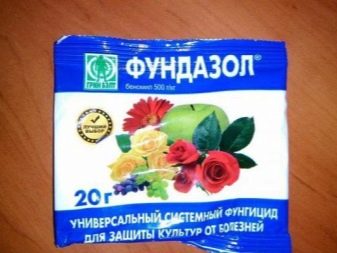
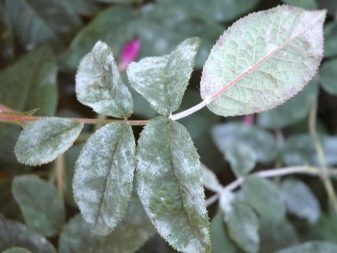
Signs of rust disease in roses begin to appear in early spring, when spots in the form of orange dust appear in the area of blossoming buds. Infection occurs much earlier, but the spores of the pathogen fungus carry the winter cold in the buds of the plant in order to begin active development when the air warms. If you do not spray the plant, then rust gives several generations of mycelium, which for years will infect all new shoots and bushes. At the same time, the leaves are also affected from the lower side and can completely wither.
Another causative agent of fungal disease is marsonium (black spot). It gains activity closer to autumn and is expressed in dark spots and purple edges on the leaves. Sometimes the disease manifests itself in the fact that the foliage acquires a brown color and falls off prematurely. The plant may not die immediately and release new leaves, but this greatly weakens the roses, which in the next season look much worse and bloom poorly. Preventive measures such as thinning plants can be used to control black spot to create good sunshine and ventilation.
Special preparations containing fungicides and a solution of copper sulfate should be used after each rain, as well as profuse dew.

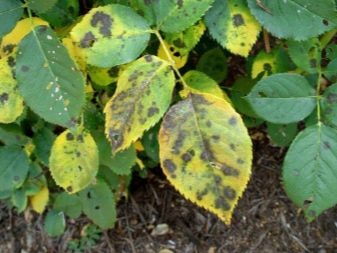
Pest control
Rose bushes can look lethargic due to pests, including thrips, leafhoppers, aphids, bronzes, ticks and other lovers of juicy greenery. You can fight them with a proven drug that has already helped in previous cases, or you can try to change the methods of treatment in order to choose the most effective method if the roses have wilted.
Spider mite
The most suitable conditions for the reproduction of a spider mite, which is clearly visible under a microscope, are high air temperatures, in the region of +30 degrees, as well as low air humidity - about 35%. In a favorable environment, tick generations are renewed on average every 2 weeks, filling all new spaces for life. These parasites harm roses by sucking all the juices from the foliage, and as a result, it dries and falls off. You can get rid of this pest with a solution of colloidal sulfur, which is used in warm weather, at temperatures above 20 degrees.
For a good effect of solutions on plants, spraying the leaves must be carried out early in the morning or at sunset.
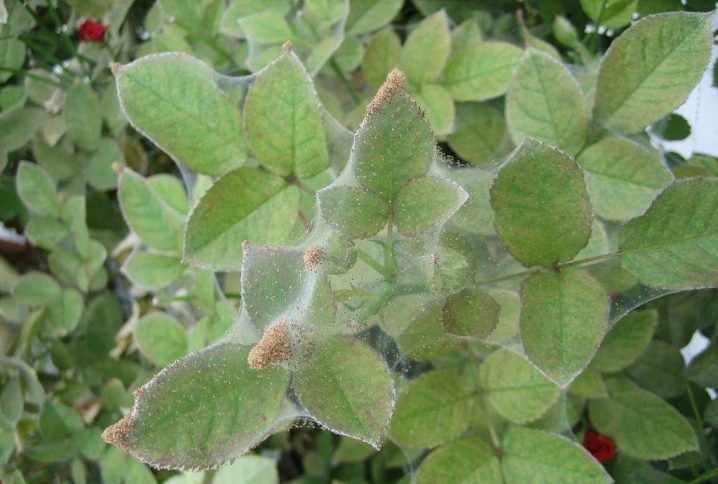
Green rose aphid
The rose has its own pest - a type of aphid that prefers to feed on and reproduce on all varieties of rose bushes, from wild rose hips to cultivated greenhouse plants. The rose aphid is distinguished by a rather large size among the insects of this species and the green color of the chitinous shell. Eggs of the pest that have successfully overwintered in the ground under fallen leaves can give up to 10 new generations in just one season. The insect's activity begins to manifest itself from the beginning of summer and continues until the onset of the first autumn days. Rose aphids usually settle on the tips of young branches or on new buds, preferring them to older, coarser leaves. It is easy to detect by curvatures at the ends of the shoots and unopened buds.
Against aphids, drugs such as "Commander", "Fufanon" and "Biotlin" are used alternately, spraying the plant with them every 10-15 days.
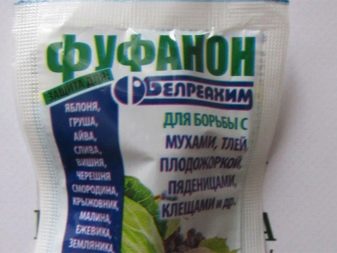
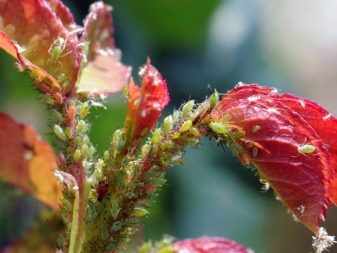
Medvedka
A large insect, 7-9 cm long, belongs to the burrowing species and lives in the ground. Medvedka eats delicious and juicy roots of wild rose and cultivated roses with pleasure. This pest is especially fond of young bushes, which are propagated by cuttings. The insect has dense wings and legs with sharp spines at the ends. It is rarely found on the surface of the soil, but the results of the actions of this pest are clearly visible.
Due to damage to the root system, individual shoots first begin to dry out, and in case of too much damage to the underground part of the plant, it may completely die. A large insect can be lured into a plastic bag with a small amount of fresh manure and then destroyed. You can also fill small bear minks with an insecticide solution that will scare away the pest.

It should always be remembered that yellowed and sluggish leaves are the primary signal that something is wrong with the plant as it is necessary for its normal life. If you do not try to immediately help him fight the malaise, then you can soon completely lose him.

































































































The comment was sent successfully.